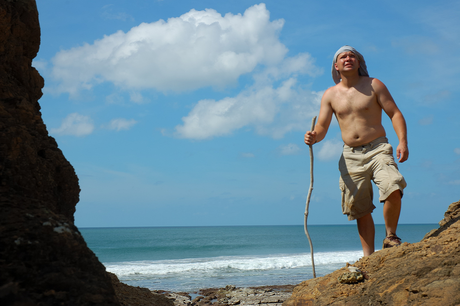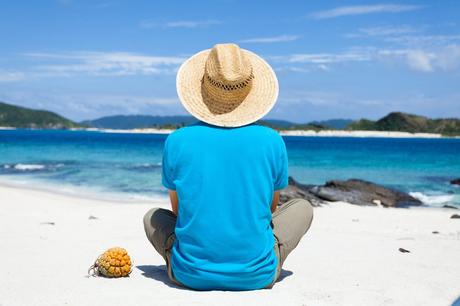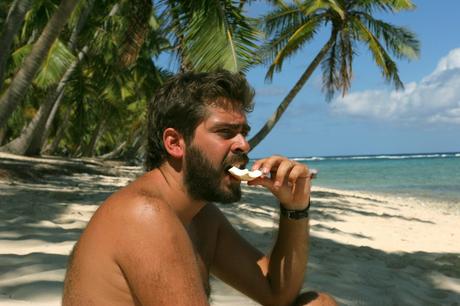Surviving on a desert island is one of those scenarios most people have considered as a possibility at least once or twice. I mean, who hasn’t imagined themselves in the shoes of Tom Hanks’ character in the movie Cast Away? We probably also thought that if we were stuck in his shoes we would do a better job than his character. However, would we really? After all, island survival involves struggling against nature, scavenging for sustenance, and even warding off illnesses!
None of these are particularly easy in such a situation. But, what if you had some guidance? Wouldn’t that make it feasible to survive in a deserted island even if the odds were against you? Well, we asked the experts, did some research, and came up with some basic guidelines to help you survive, if you ever became… a cast away.

Surviving the Arrival
Let’s make it clear; there are not a whole lot of people who purposely seek the thrill of a cast away survival experience. That is, unless they’re rich survivalist or their first name is Bear; more than likely a person stuck in this scenario arrived via one of two ways… either a shipwreck or a plane crash. Trust us when we say, none of these are pleasant experiences, and surviving through one requires more than just skill or knowledge, it also requires an inordinate amount of luck.
Plane Crashes and Shipwrecks
Both of these situations require a lot of detail and can actually be their own separate articles. But, the most important thing to remember during either of them is the golden rule of survival… which is don’t panic!
During a plane crash, remember everything that was put out during the briefing video before takeoff, and listen to any announcements made by the captain or staff. If everything goes well, the plane should touchdown on land or the water safely (relatively speaking of course) allowing the passengers to get on one of the multiple floatation devices employed by the crew.
A shipwreck follows similar logic, but you’ll be performing an abandon ship maneuver. This means you’ll be lining up to get into one of the life-rafts employed by larger ships which are designed to carry a substantial number of passengers.
On both of these, don’t push, shove, or rush any of the other passengers while they’re boarding the life rafts as you could potentially cause unnecessary loss of life and delay the process all together. Once you’re in remind yourself that a lot of tactical watches come with their own compass (someone in the boat is bound to have one or two), also try to grab one of the available maps that can be found in both ships and planes these will help you navigate if you were keeping track of your location (unlikely, but not implausible); if anyone is familiar with seafaring navigation, ask them for guidance during the night. Stars are to this day a sailor’s best friend for a reason.
If you’re lucky you’ll wash up near civilization, if you’re somewhat lucky, you’ll end up in an island with available resources you can exploit to survive. If you’re not lucky at all, you’ll end up stranded or on a barren piece of land.
The Arrival
Once you’ve safely washed ashore, remain calm and optimistic, if you have any fellow survivors with you, do your best to ease any concerns they might have. If one person panics, the chance of hysteria spreading among the rest increases exponentially, your job is to prevent that from happening.
Furthermore, a positive attitude is contagious, and numerous survivors have shared stories about how their optimism kept them going even when things looked bleak. Low morale is one of the biggest threats in any survival scenario (including military work in general), and more people will succumb to despair rather than illness.
Keep a clear head, and familiarize yourself with your surroundings after everyone has calmed down. Do some short distance scouting and look for easy to access to nearby resources (bring some people along in case something happens or you need extra hands). Additionally, anything you can take from your boat or aircraft are fair game and in fact should be brought along for the ride as they will make it easier in the long run.
Planes and cruises carry a good amount of food and drinks that can be used without expending too much energy or effort (especially while you are still figuring things out). You can also use some of the materials salvaged for shelter. Of course, if that fails, you can always tear off the seats and use the cushions as simple furniture.
Basically, you’ll have to be as creative as possible in providing yourself with creature comforts. Some of the most important items to look for are multi-tools and anything that can be used as a weapon. Knives in particular are extremely crucial. Finding one means your odds of survival increase substantially.
Finding any hammers, axes, light sources, and even flammable materials will further increase those odds of survival. Basically, anything that you think can potentially have a good use in the future is worth keeping around your base of operations. But, try not to get into any dangerous situations while you’re exploring and gathering.
Avoiding Additional Dangers

Another important aspect of island survival you have to keep in mind is avoiding hazards. This is because once you’ve passed the initial threat of the plane crash or shipwreck; your chances of getting hurt actually increase as you lower your guard.
However, make no mistake, you might be out of the immediate danger, but you’re not by any means safe. You’re still in a survival situation and that means taking care of any injuries, scrapes, cuts, and bruises as well as staying alert at all times.
A lot of these injuries can turn deadly if they become infected, and there is nothing worse than dealing with an infection or sepsis (which typically results in gangrene and amputation) while in an unknown location. As such, it’s imperative that you prioritize first aid treatment at all cost.
There are a lot of dangers that can crop up on the shores of a deserted island. Anything from coral reefs to poisonous beach dwellers which like to hide in the sand can become a serious threat to any nearby survivors. We recommend using some protective footwear over anything else while escaping for this very reason.
Finding Water
Regardless of what survival situation you find yourself in, you’ll need water to make it through alive. A few days without water and you’ll be dead, but even mild dehydration is a threat as it impacts your ability to act rationally.
Most tropical islands will have coconuts, and they should theoretically be your first source of hydration. However, be careful as too much coconut milk will cause you to get diarrhea, further decreasing your chances of staying hydrated.
Other options involve searching for fresh water streams nearby and looking for caves that have water dripping from the stalactites inside due to condensation. Of course, this water still needs to be purified as any expert will tell you that certain pathogens and parasites can be found living in the water… even if you can see fish living healthily inside it is by no means safe to drink right away.
Alternatively, if it rains make sure you find storage containers that can be used to hold water for future use. Storms will be your best friend, as long as you got shelter to protect yourself from exposure to the weather of course.
Still, if you happened to land on a barren piece of land, and there is nothing except salt water in the surrounding area, then you’ll need to get really creative. Because your only option will be purifying the saltwater into distilled water, and the best way to do that is using a solar-still that can gather water for you in a small container, but as long as there is plenty of sunlight available it should work pretty well.
Finding Food

Tropical islands typically have a large variety of food sources available for the crafty survivalist. The ocean will provide you with all types of shellfish, and critters that can be eaten, but please stick to fish you recognize as safe to eat.
Pro Tip: Shellfish that are difficult to open tend to be healthy and safe to eat. Alternatively, if they open too handily, then they’re probably sick and will poison you if ingested. Regardless of their health though, always cook them thoroughly as this will eliminate most parasites.
Away from the beach, you can typically find fruits and veggies that grow in the rich island soil. Stick to the recognizable fruits first, stuff like oranges, lemons, coconuts, root veggies, breadfruit, bananas, plantains, mangoes, avocados, starfruit, and so forth are some of the most commonly found ones, they’re also typically safe to eat by most individuals.
Pro Tip: Always make sure you aren’t allergic to a certain fruit before eating it. Try rubbing some on your skin and waiting if nothing happens, repeat the same procedure with your lips, then your tongue; finally take a small bite and wait a few minutes. More than likely, you’ll be fine if you followed these steps without having any reactions. Alternatively, you die… but, that’s a worst case scenario we’re talking about.
Building a Shelter
We’ve saved building a shelter for last for a specific reason, and that is because it’s good to build one that’s located more or less in the middle of everything. This will prevent you from taking long trips to gather food or water, and will help you save energy in the long run.
But, shelter provides more important functions than just a central hub to recover as exposure will kill you faster than almost anything else on the island. Rain is common in these places, the cold nightly air can give you hypothermia, ultra violet rays will cause sunburn, and nocturnal animals set out to hunt in the dark. Having a shelter will protect you from most of these threats and help you retain your strength during the ordeal.
Your first objective should be building a fire, this will keep away some of the threats and help you stay warm at night. Plus, the fire will make it easier to find you as smoke signals are still widely recognized throughout the world. Finding your way back will also be easier if there is somebody ensuring the fire stays lit at all times.
The actual shelter, though, should consist of a combination of salvaged items from the crash and materials found on the island such as palm leaves and other coverings. You can potentially make it as simple or as complicated as your imagination (and skills) will allow.
The important things to remember are:
- Keep your bed off the ground
- Protect yourself from mosquitoes and other disease vectors
- Falling coconuts kill more people than sharks each year so stay away from palm trees
- Keep your fire going as constantly as possible
Finally, we always recommend having a bug-out-bag regardless of whatever scenario you find yourself in. But, there are some items that can be extremely useful to have in you’re in a deserted island. These are:
- Signal mirrors
- Cellphones
- A photo of your family or loved ones
- A fire starter kit or waterproof matches
- A survival knife
- Survival books
- Snacks
- Mosquito repellent
- Solar chargers
Having these around is optional, but the help they provide is immense. A signal mirror will help you signal any nearby planes or boats that can be in the nearby area. A cellphone on the other hand, might ping antennas from nearby location that will assist rescuers in pinpointing your location, especially at night (try sending out a message even if it doesn’t get received by the other party).
A picture of your loved ones will help you stay sane, and motivated to survive. Nothing increases the odds of survival more than keeping hope alive. By reminding yourself of what you have to come back home to, you’ll be able to stay positive throughout your ordeal.
Fire starter kits or some waterproof matches will help you set up a campfire or restart it should it go out for any reason, plus you won’t have to expend additionally energy by manually starting one with the infamous rotating stick on a wooden plank method popularized by movies.
A survival knife will provide you with a means of defense and a way to peel off skin from any animals you might have hunted/trapped or fruit you gathered. Books on the other hand will provide you with basic or advanced knowledge of your surroundings and how to react to any potential scenarios encountered.
Snacks will provide you with a quick boost in energy in case you haven’t been able to locate some real food, and finally a mosquito repellent will keep away any disease carrying insects that are looking to steal your blood.
In essence, island survival comes down to a few, but very crucial aspects. Surviving the initial scenario that got you in that situation, finding water/food, avoiding any additional threats, and building a shelter. If your basic needs are met, you can survive for extended periods of time until you’re rescued. It’s not impossible, but it will be hard… you just have to remain hopeful that someone will eventually rescue you and you’ll escape to tell your tale. If you’re lucky enough to have a bug-out-bag with you, your chances of survival are better, but it won’t do you any good without the creativity needed to survive. Just keep a level head, help everyone in the group, and remember that survival is a lifestyle choice that anyone can make, but few can master.

